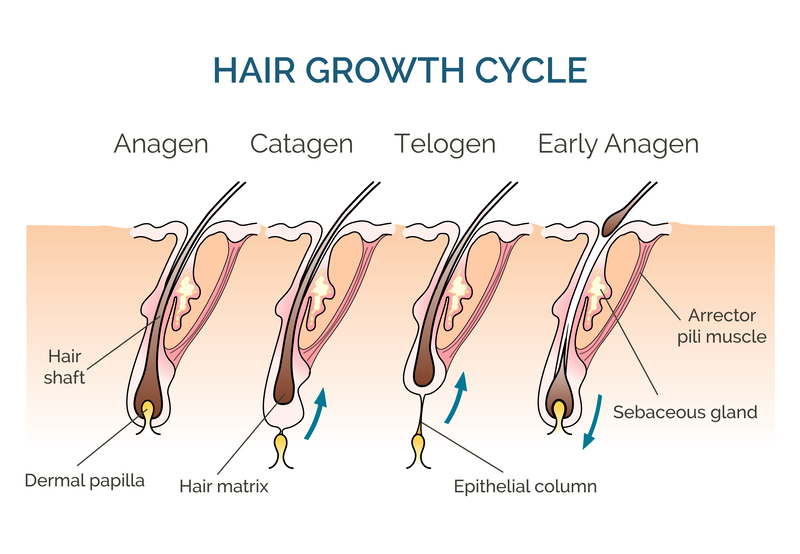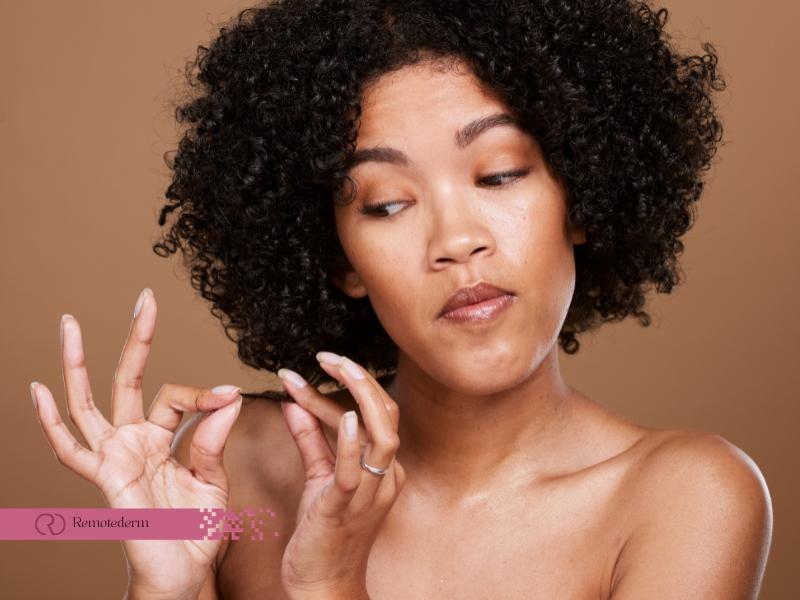Understanding the intricate path of hair growth stages is vital for tackling hair loss challenges and optimizing overall hair health in Canada. The hair growth stages encompass three phases: Anagen, the period of active growth; Catagen, a transitional phase; and Telogen, a stage of rest and renewal. This well-balanced cycle prevents simultaneous hair loss or growth. This article explores the interconnection between hair loss and growth, addressing conditions like anagen effluvium and folliculitis, which can affect Canadians, especially with changing climates. Additionally, it introduces holistic approaches such as scalp massage and proper nutrition, empowering readers to unlock the full potential of their hair and appreciate each phase in the hair growth stages.
The Fundamentals of Hair Growth Stages
Delving deeper into the science of our hair can provide valuable insights into the challenges of hair loss and the pathways towards healthier locks. The lifecycle of each hair strand is an intricate, ceaseless journey, one that is essential to comprehend for the effective maintenance of healthy hair. There are three distinct stages through which each follicle progresses, each playing a vital role in the continuous cycle of growth, rest, and renewal:
- Anagen Phase: This is where the journey begins, with each strand of hair sprouting from its follicle and growing actively. This phase can last anywhere from two to seven years and is the period where our hair is at its most vibrant and dynamic.
- Catagen Phase: Following the heights of activity comes a time of transition. Lasting around two weeks, this phase sees the hair follicle shrink and detach from the dermal papilla, a critical step towards renewal.
- Telogen Phase: Here, the hair enters a well-deserved period of rest. For about three months, the old hair remains in place as the new hair begins its journey underneath. This stage culminates with the shedding of the hair, making way for fresh growth.

These stages work in a meticulous cycle, ensuring that at any given time, different strands are at various stages of this process – a biological balancing act preventing all our hair from falling out or growing at once. Moreover, understanding these phases helps us recognize and respect the natural limits and rhythms of our body’s hair production. For instance, it normalizes that some daily hair loss is standard, as each follicle individually concludes its telogen phase.
The Intricate Connection Between Hair Loss and Hair Growth
The life cycle of hair is an intricate process that is essential for continuous hair renewal. As we delve into the conditions that disrupt this cycle, it’s crucial to grasp how each stage of hair growth relates to the health and longevity of our hair strands. This deeper insight will equip us to counteract hair loss more effectively and maintain a healthier scalp.
Hair Loss: A Concern We All Face
A common problem that affects people of all ages is hair loss. Factors such as genetics, hormonal changes, and lifestyle choices can contribute to hair loss. This section will explore how the hair growth stages are interlinked with issues like anagen effluvium, folliculitis, and more.
Anagen Effluvium: Unraveling the Mystery
Anagen effluvium is a condition where the hair’s anagen phase is significantly shortened, leading to sudden hair loss. This can be triggered by exposure to toxins, certain medications, or even chemotherapy. Understanding this phenomenon empowers individuals to seek timely interventions and explore options like consulting an online hair loss dermatologist.
Folliculitis and its Impact on Hair Health
Folliculitis, an inflammation of hair follicles, can disrupt the normal hair growth cycle. It often manifests as red, swollen bumps on the scalp and can be caused by bacterial or fungal infections. Incorporating proper scalp hygiene practices and treatments can mitigate the impact of folliculitis on your hair’s well-being.
Holistic Approaches to Promote Hair Growth
Embracing holistic methods for hair care can be a transformative approach to managing and improving hair growth, especially for Canadians dealing with various environmental factors. These strategies emphasize nurturing both internal health and external treatments to work in harmony. From traditional techniques to dietary adjustments, we’ll explore how maintaining a balanced lifestyle is key to creating the optimal conditions for robust hair growth in Canada’s diverse climate.
1. Scalp Massage for Hair Growth
A simple yet effective technique to enhance hair growth is through regular scalp massage. This practice stimulates blood flow to the hair follicles, promoting nutrient delivery and oxygenation. Incorporating scalp massage for hair growth into your routine not only supports the hair growth cycle but also provides a relaxing self-care ritual.
2. Nourishing Your Mane: Food for Hair Growth
Nutrition plays a pivotal role in maintaining healthy hair. Include nutrient-rich food for hair growth in your diet, such as those high in vitamins A, E, and D, as well as biotin and omega-3 fatty acids. These elements contribute to the strength and vitality of your hair, positively impacting the hair growth stages.

3. Exercise and Hair Loss: Finding the Balance
The relationship between exercise and hair loss is one with many benefits. Regular exercise is not only beneficial for your overall health but can also influence your hair’s well-being. Striking a balance is crucial, as excessive exercise or intense workouts may contribute to stress-related hair loss. Prioritize a healthy exercise routine to impact your hair growth cycle positively.
Final Thoughts
Understanding the stages of hair growth—Anagen, Catagen, and Telogen—is essential for tackling hair loss and optimizing scalp health. These stages work together to ensure a healthy cycle of hair growth and rest. By recognizing the natural processes of hair production, individuals can better manage hair loss and promote overall hair health. In Canada, embracing holistic hair care methods, including scalp massages, balanced nutrition, and exercise, can enhance this process and provide a strong foundation for healthy hair growth. These strategies, along with professional care, empower you to unlock the full potential of your hair.
FAQs
Can stress affect the hair growth stages?
Chronic stress can negatively influence the hair growth cycle, primarily by pushing hair follicles prematurely into the telogen phase, which can lead to increased shedding and hair loss. Managing stress through mindfulness, therapy, and lifestyle changes is essential to maintaining normal hair growth stages.
How does pregnancy alter the hair growth stages?
During pregnancy, many women experience changes in their hair due to hormonal shifts; often, the anagen phase is prolonged, leading to thicker, fuller hair. However, after childbirth, the hair can suddenly shift to the telogen phase, resulting in temporary hair shedding, known as postpartum hair loss.
Can wearing hats frequently disrupt the hair growth stages?
Wearing hats does not typically disrupt the natural hair growth stages, but excessive friction or pressure on the hair follicles from very tight hats might contribute to traction alopecia, a condition caused by pulling on the roots of the hair.
Do hair care products have an effect on the hair growth stages?
Certain hair care products containing growth stimulants like minoxidil can positively impact the hair growth stages by prolonging the anagen phase. Conversely, some harsh chemicals found in treatments or styling products may damage hair follicles and potentially alter the normal hair growth cycle.
